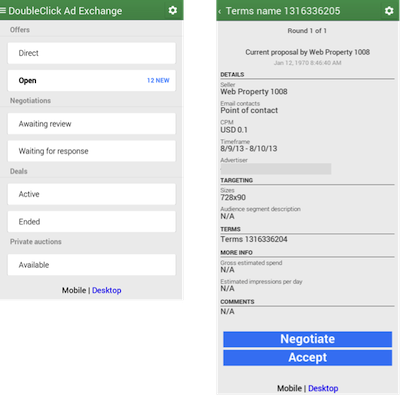DoubleClick Ad Exchange (AdX) launched the first Preferred Deal in 2012 and the first Private Auction in 2013 to help publishers and advertisers create greater opportunities with programmatic buying. Since the beginning of this year we’ve seen the number of Preferred Deals double, the number of Preferred Deals impressions grow by 2.5X, and Private Auction impressions explode from nothing to millions per day. As these programmatic deal types become more important for our partners, they started asking for the ability to negotiate deals on the go. So today, we’re excited to launch a Mobile version of the DoubleClick Ad Exchange Deals interface.
Negotiate on the go
The new DoubleClick Ad Exchange Deals interface for mobile allows buyers and sellers to check the status of a Preferred Deal or Private Auction on any device. When you sign into the Deals interface on your phone or tablet, the mobile site will load automatically. From there, buyers and sellers can view, edit, accept, or stop existing deals.
If at any time you need to access other features, you can switch to the classic version of the Deals UI by clicking on the Desktop link at the bottom of the screen.
We built this mobile interface to help DoubleClick Ad Exchange partners continue their deal negotiations while away from their desks and it’s available now for all users. To access it, just visit www.google.com/adxbuyer/uploader from your mobile browser and visit our Help Center for buyers or Help Center for sellers to learn more.
Posted by Michael Smith, Product Manager
Built by Brandon Krieger, Software Engineering Intern
